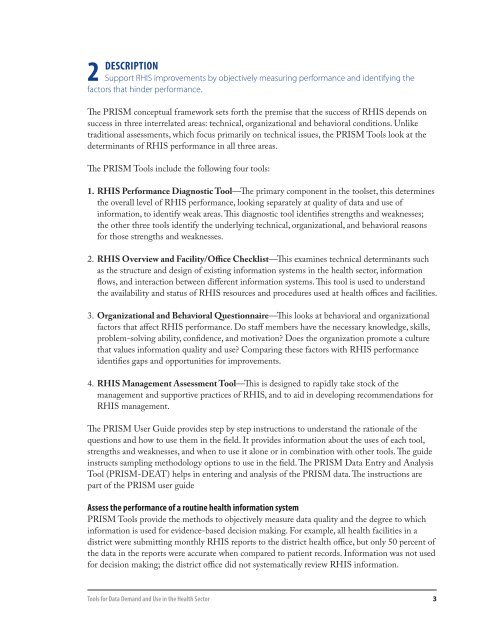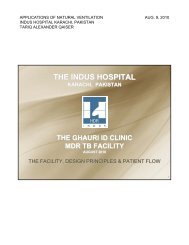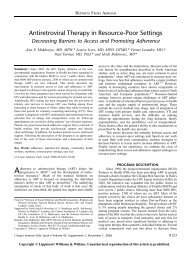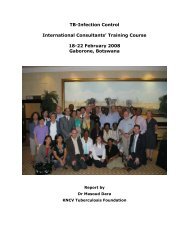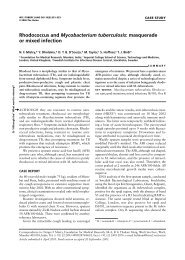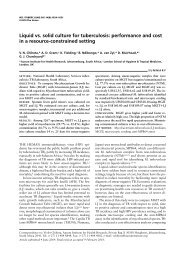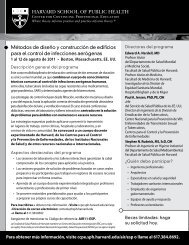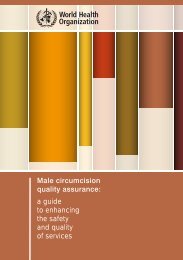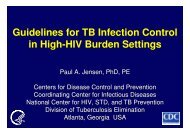PRISM_DescriptionOfTools.pdf - GHDonline
PRISM_DescriptionOfTools.pdf - GHDonline
PRISM_DescriptionOfTools.pdf - GHDonline
Create successful ePaper yourself
Turn your PDF publications into a flip-book with our unique Google optimized e-Paper software.
2 description<br />
Support RHIS improvements by objectively measuring performance and identifying the<br />
factors that hinder performance.<br />
The <strong>PRISM</strong> conceptual framework sets forth the premise that the success of RHIS depends on<br />
success in three interrelated areas: technical, organizational and behavioral conditions. Unlike<br />
traditional assessments, which focus primarily on technical issues, the <strong>PRISM</strong> Tools look at the<br />
determinants of RHIS performance in all three areas.<br />
The <strong>PRISM</strong> Tools include the following four tools:<br />
1. RHIS Performance Diagnostic Tool—The primary component in the toolset, this determines<br />
the overall level of RHIS performance, looking separately at quality of data and use of<br />
information, to identify weak areas. This diagnostic tool identifies strengths and weaknesses;<br />
the other three tools identify the underlying technical, organizational, and behavioral reasons<br />
for those strengths and weaknesses.<br />
2. RHIS Overview and Facility/Office Checklist—This examines technical determinants such<br />
as the structure and design of existing information systems in the health sector, information<br />
flows, and interaction between different information systems. This tool is used to understand<br />
the availability and status of RHIS resources and procedures used at health offices and facilities.<br />
3. Organizational and Behavioral Questionnaire—This looks at behavioral and organizational<br />
factors that affect RHIS performance. Do staff members have the necessary knowledge, skills,<br />
problem-solving ability, confidence, and motivation? Does the organization promote a culture<br />
that values information quality and use? Comparing these factors with RHIS performance<br />
identifies gaps and opportunities for improvements.<br />
4. RHIS Management Assessment Tool—This is designed to rapidly take stock of the<br />
management and supportive practices of RHIS, and to aid in developing recommendations for<br />
RHIS management.<br />
The <strong>PRISM</strong> User Guide provides step by step instructions to understand the rationale of the<br />
questions and how to use them in the field. It provides information about the uses of each tool,<br />
strengths and weaknesses, and when to use it alone or in combination with other tools. The guide<br />
instructs sampling methodology options to use in the field. The <strong>PRISM</strong> Data Entry and Analysis<br />
Tool (<strong>PRISM</strong>-DEAT) helps in entering and analysis of the <strong>PRISM</strong> data. The instructions are<br />
part of the <strong>PRISM</strong> user guide<br />
Assess the performance of a routine health information system<br />
<strong>PRISM</strong> Tools provide the methods to objectively measure data quality and the degree to which<br />
information is used for evidence-based decision making. For example, all health facilities in a<br />
district were submitting monthly RHIS reports to the district health office, but only 50 percent of<br />
the data in the reports were accurate when compared to patient records. Information was not used<br />
for decision making; the district office did not systematically review RHIS information.<br />
Tools for Data Demand and Use in the Health Sector<br />
3


